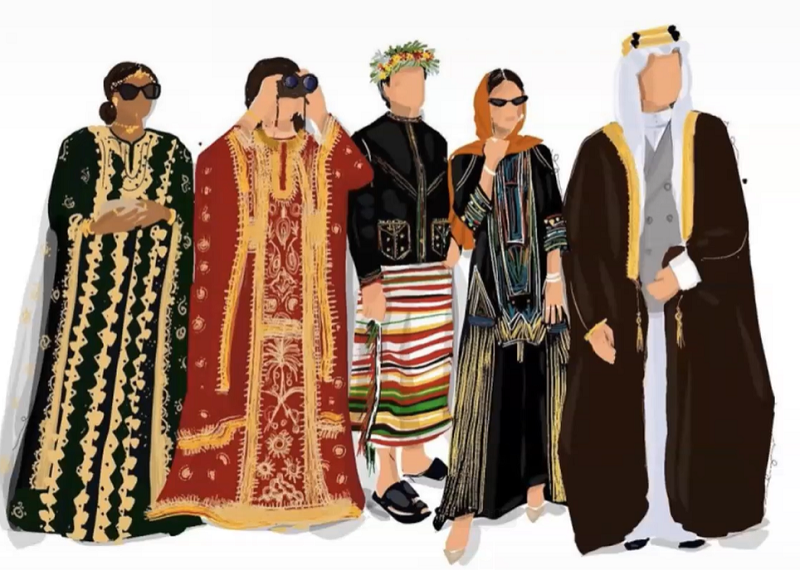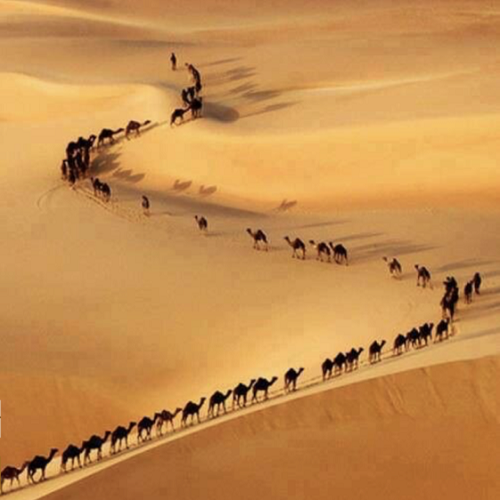As part of our ongoing series Dialogues on the Art of Arab Fashion, we held our inaugural panel discussion on
The Importance of Heritage Studies in Arab Fashion – Educating the next generation of a sustainable future on 31 May 2022. This is a short introduction and a few highlights from that conversation.
Dr Reem was in conversation with
PROF REINA LEWIS – Centenary Professor of Cultural Studies at London College of Fashion;
DR TANYA WHITE – Assistant Professor of Material Practices in Fashion at The Creative School, Toronto Metropolitan University; and
DR AHMED MELIEBARY – Assistant professor of language at the University of Nottingham
.
The Arab World
The Arab world is not one homogenous place – it is a geographical area that spans two continents and includes several countries. These countries are all home to different people groups, ethnicities, and faiths. And even though the Arabic language is one of the most significant unifiers in the Arab world, dialects and language patterns differ from one region to the next - so much so that it is at times difficult to understand each other!
The Arabic Language
Arabic is a language of local dialects that may differ from country to country and even from village to village! Although Modern Standard Arabic (MSA) is used by governments and in school textbooks across the Arab world, it is not spoken as the everyday language of the common people. Each area has their spoken dialect known as
ammiyah, or
darijah, meaning ‘everyday colloquial language.’ These colloquial dialects have cognates from Modern Standard Arabic, but they also borrow significantly from the language of the indigenous tribes or their historical colonial occupier.
In our world of fashion and dress heritage,
we often deal with challenges such as the same garment being referred to by different names in different places, or the opposite where the same word is used to describe different garments in different regions.
source: www.arabfashionweek.org
Layers of Society
As with most other regions in the world, Arab society functioned in layers or social hierarchies that vary from nomadic, rural and pastoral people, to business operators and traders, to the nobility, rulers and other upper classes. These layers are even more fractured and multidimensional when gender differences and geographical disparities are taken into account. Nomadic desert dwelling people live, work, dress, and talk differently from those who live in agricultural communities or urban areas, or even those who made their living from the ocean through fishing and pearl diving.
As I have become a visitor to Makkah, rather than a resident,
I have noticed the difference in traditional dress over the past
three decades of travelling back and forth. I have noticed dramatic
changes in how traditional appearances are changing as we speak.
Dr Ahmad Meliebary
Carpet trading at a caravanserai in Marrakesh, Morocco
Outside Influences – Trade and commerce
As varied and multilayered as the Arab world and its people are, outside forces and influences have brought with it even more diversity and complexity over the centuries, which continues in today’s world of globalisation. Although some of these outside influences have enriched and diversified Arab heritage, others have brought with them a lot of pain and lasting scars.
The area known as the Middle East has for centuries been the crossroads for trade routes between continents and civilisations ranging from Persia in the north and Egypt to the south, and China in the East to Europe in the West. These trade routes brought with them produce and commodities such as threads, textiles, beads, precious stones, gold, and silver. It also introduced people from this region to styles of dress and ways of life that they have adopted and adapted into their customs and traditions.
Outside Influences – Conquerers and Colonisers
Empires such as the Romans, Ottomans, Egyptians, and Persians all conquered, ruled, and influenced parts of the Arab world in different eras throughout history. All of them brought with them customs that were in some way or form incorporated into the local lexicon of everyday life.
The most recent of these conquests or invasions, and the one that is still fresh in the current generation’s memory is that of the British and French colonialism.
It has left its mark and we are still untangling and dealing with the aftermath of that. Again, as we’ve seen throughout history, Arab customs, traditions, heritage, and culture absorbed influences and impressions from these sources.
Not only does heritage teach us about the symbolic meaning of dress but it also teaches us about their practice and ritual. I am interested in the stories that are carried in dress and textiles. It is important for students to understand the foundationmof heritage before they start expressing new ideas. Using new ideas without foundational understanding can unintentionally lead to offence or perpetuation of false assumptions.
Dr Tanya White
Arab Fashion Week. source: masala.com
Globalisation
Today, we are witnessing unprecedented globalisation brought on by the internet, air travel, and a global economy. The discovery of oil has changed the Arab world forever. World-class cities such as Dubai and Abu Dhabi are bringing the world to us on a scale that has not been seen before.
This very same
globalisation has also taken the Arab world to the rest of the world. People from across the globe are now interested and learning about our culture. The mystery and mystique often associated with Arab culture are being revealed. The danger is that we are now more vulnerable and exposed to losing our culture than ever before. The younger generation who are born into this globalised world don’t know what they are missing, and it is our mission at The
Zay
Zay: (Arabic: costume, Pl. azyaā’), a set of clothes in a style typical of a particular country or historical period. initiative to not only preserve the past but to educate and inform the future.
Arab Fashion Week. source: BBC
Dynamic Heritage
Saying all of this, it is evident and important to understand that our culture and heritage are not static – they never were and never will be. It changes as the world changes. Yet, there is a thread that binds it all together. A cultural language that is based on our spoken words but that goes far beyond it - the thing that makes us belong, that binds us together, that makes us Arab. We, at The
Zay
Zay: (Arabic: costume, Pl. azyaā’), a set of clothes in a style typical of a particular country or historical period. Initiative, find that thread in the clothes we wear and in the ways we adorn our bodies.
If we think of how this lack of cultural heritage studies impacts cultural appropriation, we need to diversify the whole industry, not just the designers, but also the models, the product designers, merchandising, marketing, media, etc. An increase in the knowledge base of cultural heritage will also allow the market and industry to grow a more nuanced understanding of the range of opinions within a culture.
Professor Reina Lewis
The
Zay
Zay: (Arabic: costume, Pl. azyaā’), a set of clothes in a style typical of a particular country or historical period. Initiative is collaborating with Emirati fashion brand NIILI in Zaman Awwal in the Mall of the Emirates
Conclusion
Education is the key to sustaining Arab heritage and culture. Studying dress and textile heritage can lead to a better understanding of both gender and social relationships throughout history. Cultural misappropriation in the marketplace demonstrates the need for more education about cultural heritage in the fashion industry. Our role as heritage educators is to ensure that the current generation of designers and creatives is equipped to carry the Arab cultural legacy into the future. By understanding and preserving the origins of traditional artisan crafts like embroidery, weaving, and natural dyeing, unethical practices can be avoided, and the new generation of fashion design students will be appropriately equipped to ensure a sustainable future fashion heritage.
Dr Reem and our panel of specialist guests on the webinar
Our Panel
Professor Reina Lewis is an academic and public intellectual and Centenary Professor of Cultural Studies at London College of Fashion, UAL. Her books include Muslim Fashion: Contemporary Style Cultures (2015), Rethinking Orientalism: Women, Travel and the Ottoman Harem (2004), and Gendering Orientalism: Race, Femininity and Representation (1996). She is the editor of Modest Fashion: Styling Bodies, Mediating Faith, (2013), and Outlooks: Lesbian and Gay Visual Cultures (1996) with Peter Horne. Reina was consulting curator for the exhibition Contemporary Muslim Fashions (2018) and is co-editor of the accompanying catalogue with Jill D’Allesandro.
Dr Tanya White, PhD, has worked in ready-to-wear, bridal, marine canvas, and costume design in the Greater Toronto Area. Tanya recently completed a practice-based PhD at Glasgow School of Art with a fashion and textile specialisation exploring the co-relation of religious and fashion iconography that idolises an emaciated body in historical and contemporary media. This study is expressed in experimental cloth and soft wearable sculpture.
Dr Ahmad Meliebary, originally from the holy city of Makkah in the Kingdom of Saudi Arabia, has a higher education and educational career spanning KSA, USA, and the UK. He is a staff member at the School of Cultures, Languages, and Area Studies (CLAS) at the University of Nottingham in the UK. His speciality is Stylistics (English and Arabic) and he has a special interest in visually based calligraphy and fine arts in general.
***
By becoming a
Friend of The Zay
Zay: (Arabic: costume, Pl. azyaā’), a set of clothes in a style typical of a particular country or historical period., you can get access to our library of webinar and podcast recordings, receive complimentary access to our future webinars, and join us at behind-the-scenes conversations with our guests after each webinar event. In the process, you will help support our work and research.





